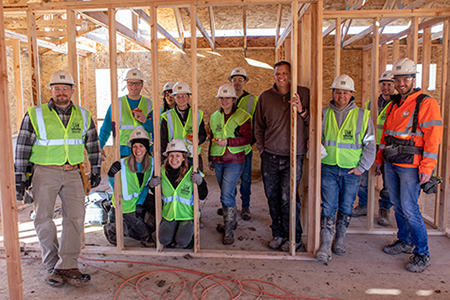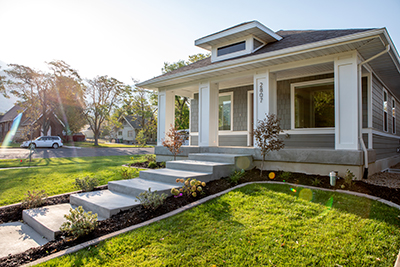Weber State Waits Announcement of Department of Energy Solar Decathlon Winner
On April 18, the U.S. Department of Energy will announce the winner of its international Solar Decathlon Build Challenge, and Weber State University is one of the nine finalists selected from teams around the world. The public will be able to tour the homes virtually, April 12 and 13.
 The Solar Decathlon is a collegiate competition in which student teams design and build high-performance, low-carbon homes powered by renewables. The winners are those teams that best blend architectural and engineering excellence with innovation. Weber State students, under the direction of Building Design & Construction Professor Jeremy Farner, built the net-zero home in central Ogden. The home, at 2807 Quincy Ave., is now occupied by homeowners, who were selected from a pool of interested buyers during the grand opening in October 2020.
The Solar Decathlon is a collegiate competition in which student teams design and build high-performance, low-carbon homes powered by renewables. The winners are those teams that best blend architectural and engineering excellence with innovation. Weber State students, under the direction of Building Design & Construction Professor Jeremy Farner, built the net-zero home in central Ogden. The home, at 2807 Quincy Ave., is now occupied by homeowners, who were selected from a pool of interested buyers during the grand opening in October 2020.
The Build Challenge competition and public exhibition were previously scheduled to take place on the National Mall in Washington, D.C., during the summer of 2020. Because of COVID, this event was postponed and transitioned to a local build event, with teams constructing homes in their local communities, where they will remain after the competition.
The final phase has moved online, and the Department of Energy Solar Decathlon will open its Virtual Village on April 12, with online 3-D tours of all nine competing homes. Tours will be available at the following times and links.
- Apr 12, 2021, 3:30-5:30 p.m. MST – general public
- Apr 13, 2021, 11 a.m.-1 p.m. MST – teachers and students
- Apr 13, 2021, 2:30-4:30 p.m. MST – industry professionals
Visitors can participate in a Solar Decathlon home scavenger hunt, and teachers can access a toolkit to help their students visit the village for unique educational activities.
 The awards ceremony will be held, Sunday, April 18, 11 a.m.-1 p.m. (MST). DOE Secretary Jennifer Granholm will announce the overall winner of the Solar Decathlon Build Challenge, starting around noon (MST). Register for Zoom event
The awards ceremony will be held, Sunday, April 18, 11 a.m.-1 p.m. (MST). DOE Secretary Jennifer Granholm will announce the overall winner of the Solar Decathlon Build Challenge, starting around noon (MST). Register for Zoom event
“One cool thing is the collaboration that was undertaken on this home with the city, the Ogden Civic Action Network, the university and our department,” Farner said. “It was all funded by the university as a way to give back to the community as well as to provide real-world experiences to students. We successfully completed our project as planned, despite the challenge of COVID, and we now are beginning the next net-zero home.”
Janae Thomas, who graduated in spring 2020, was the student project manager. She took on the monumental task because she said the future of transportation, housing and urban planning for her daughter depends on making a difference today.
“I found myself in construction because of the industry’s ability to directly impact environmental concerns and human well-being,” Thomas said. “This house showcases numerous economic solutions to improve Utah’s air quality. This house is simple to reproduce, inviting to live in and built to last generations. I’ll be proud to drive by this house and tell my children, and their children, ‘I built that.’”
The Quincy Avenue home is designed to make the “True Cost of Ownership”' affordable by nearly eliminating all energy bills. Energy costs to operate the home are estimated at just over $100 annually or around $9 per month to be connected to the electrical grid. Weber State will monitor power bills for two years to make adjustments if the HVAC and solar systems are not performing as they were designed.
 Nine teams are in the finals of the 2020 Solar Decathlon
Nine teams are in the finals of the 2020 Solar Decathlon
- Hogeschool Utrecht University of Applied Sciences Utrecht, Utrecht, Netherlands
- Kansas State University, Manhattan, Kansas
- Universidad Técnica Federico Santa María, Valparaíso, Chile
- University of Colorado, Boulder, Colorado
- University of Denver, Denver, Colorado
- University of Illinois at Urbana-Champaign, Urbana, Illinois
- University of Nevada, Las Vegas, Las Vegas, Nevada
- University of Waterloo, Waterloo, Ontario
- Weber State University, Ogden, Utah
For more information or pictures of the project under construction, visit weber.edu/solardecathlon. To follow the team on social media, use @wsusolardecathlon2020 on Instagram.
Visit weber.edu/wsutoday for more news about Weber State University.
Allison Barlow Hess, Public Relations director
801-626-7948 • ahess@weber.edu- Contact:
Jeremy Farner, Design Engineering Technology associate professor
801-395-3421 • jfarner@weber.edu